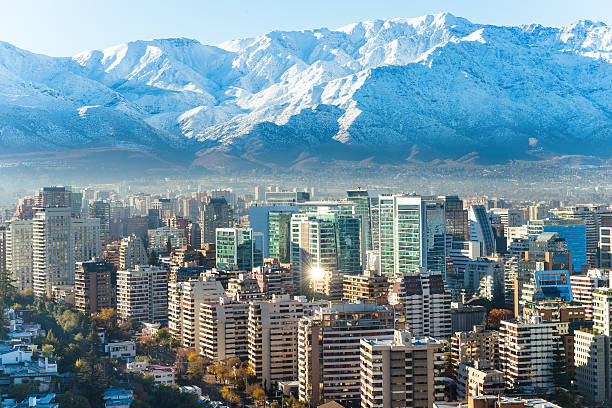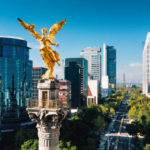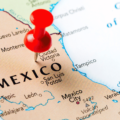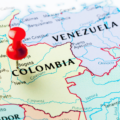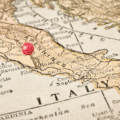Have you ever wondered if there’s a city in South America that has that perfect mix of modern infrastructure and vibrant culture? I’m Jeff, “the chilled nomad,” and after years of traveling full-time, I can tell you that finding that sweet spot is everything. On a recent trip, I landed in Santiago, and I have to say, it completely surprised me. I’ve put together this detailed guide based on my time there, and I think it will be a huge help if you’re lucky enough to visit this incredible city.
As one of the continent’s safest and most developed cities, Santiago gives us digital nomads a fantastic quality of life. It also has a seriously good remote working environment, with plenty of thriving coworking spaces and coliving communities that make it easy to connect.
The city is a cool blend of new-world efficiency and old-world charm. You get diverse cultural experiences right at your doorstep, plus super easy access to some epic outdoor adventures. Let’s get into it.
Overview: Why Santiago Is a Great Destination for Digital Nomads
Are you looking for a city with a rich culture, a reputation for safety, and an affordable cost of living? Honestly, Santiago de Chile should be high on your list. While it’s sometimes been overlooked in favor of places like Medellín or Mexico City, Santiago has really come into its own as a hub for creativity and innovation.
The city is buzzing with energy, partly thanks to initiatives like Start-Up Chile, an accelerator that has been drawing entrepreneurs from all over the world. This has created a great ecosystem for remote workers. You’ll find a ton of great coworking spaces, a really interesting cultural scene, and amazing access to outdoor fun like hiking and even skiing.
Key Takeaways
- Santiago, Chile, is a top-tier destination for digital nomads, offering an affordable cost of living, a vibrant cultural scene, and a safe environment.
- You’ll find plenty of accommodation options here, from modern co-living spaces and countless Airbnb rentals to budget-friendly hostels.
- The coworking scene is excellent, with top spots like WeWork, Launch Coworking, and CoWork Latam attracting a global community of remote workers. These spaces are perfect for networking and getting work done without a hitch.
Affordable Cost of Living
One of the biggest draws for me was Santiago’s affordable cost of living, especially when you compare it to major cities in North America or Europe. I found I could live a really comfortable lifestyle for around $1,500 to $1,700 a month, and that included a nice apartment, food, and getting around.
Beyond just cheaper rent, the day-to-day expenses are very reasonable. For example, you can grab a delicious “menú del día” (lunch menu) at a local spot for just a few dollars. I loved exploring the city’s bustling markets like La Vega for fresh produce, which helped keep my food budget low while eating incredibly well.
Vibrant Cultural Experiences
Santiago is a true melting pot, and that means there’s always something new to discover. You can dive into authentic Chilean food at lively markets like the famous Mercado Central for seafood or La Vega for pretty much everything else.
One of my favorite things to do was just wander through different neighborhoods. You can stroll through the beautiful, green Parque Forestal, check out the incredible street art in the Bellavista district, or admire historic landmarks like Cerro Santa Lucía and the grand Palacio de la Moneda.
Safe and Welcoming Environment
As a digital nomad, feeling safe is a huge deal, and that’s an area where Santiago really shines. Chile is consistently ranked as one of the safest countries in South America, which gives you incredible peace of mind while living and working there.
Beyond the low crime rates, I was really impressed by the city’s infrastructure. The public transportation system, especially the metro, is clean, efficient, and extensive, making it super easy to get around. The city feels well-maintained, and there are plenty of bike-sharing programs if you prefer to explore on two wheels.
Thriving Co-working Spaces
Santiago’s coworking scene is seriously impressive and a huge plus for any remote worker. You have big international names like WeWork, which has several beautifully designed locations across the city, including a popular one in the Apoquindo commercial hub. There are also fantastic local chains like Launch Coworking and Co-Work Latam that offer modern amenities, high-speed internet, and of course, unlimited coffee.
I found these spaces to be more than just a place to work. They are genuine community hubs where you can network with other entrepreneurs and professionals. It’s a great way to tap into Santiago’s growing startup scene, which some people have nicknamed “Chilecon Valley.”
Cost of living in Santiago
From my experience, a single person can live very comfortably on a budget of around $1,500-$1,700 per month. This covers everything from rent and food to transportation and entertainment. Of course, this can vary based on your lifestyle, but it’s a great baseline.
Here’s a rough idea of what some basic food items cost me:
- A loaf of bread: $1.50
- A liter of milk: $1.00
- A dozen eggs: $2.00
- A pound of chicken breast: $3.50
- A pound of beef: $4.50
- A good bottle of Chilean wine: $5.00 (a major perk!)
- A cup of coffee at a nice cafe: $2.50
- A simple meal at an inexpensive restaurant: $7-10
When I first got to Santiago, I was surprised at how affordable things were. I snagged a great one-bedroom apartment in a central neighborhood for about $600 a month. My total monthly expenses, including rent, food, getting around, and having fun, usually came in around $1,600.
Best times to visit Santiago
The absolute best times to visit Santiago are during the shoulder seasons, which are spring (September to November) and fall (March to May). During these months, you get lovely mild temperatures, fewer tourist crowds, and better deals on flights and accommodation.
- Spring: This is an amazing time to be in the city. The weather is beautiful, with temperatures usually between 15°C and 25°C. Plus, if you’re there in September, you can experience the Fiestas Patrias, Chile’s national independence day celebrations, which are a massive and fun-filled cultural event.
- Fall: Fall is another fantastic option. The weather is still warm and sunny, but the summer crowds have gone home. It’s a perfect time to explore the city’s many museums and art galleries without feeling rushed.
If you’re planning a trip during the peak summer season (December to February), just be prepared for hotter weather and make sure to book your flights and place to stay well in advance.
Here are just a few of the things I loved doing in Santiago:
- Visiting the Palacio de la Moneda, the impressive seat of the Chilean government.
Hiking up Cerro Santa Lucía for some amazing city views.
- Grabbing incredible fresh seafood at the Mercado Central.
- Taking a relaxing walk through the beautiful Parque Forestal.
- Spending an afternoon at the Museum of Fine Arts (Museo Nacional de Bellas Artes).
- Taking a day trip to the colorful port city of Valparaíso.
- Visiting Viña del Mar, a really popular beach resort town.
I absolutely loved my time in Santiago. It’s an affordable city with so much to offer. One of my favorite things was the food scene; there are endless delicious and budget-friendly restaurants to explore. I also really appreciated how walkable the city is, which saved me a lot of money on transportation.
Accommodation For Digital Nomads In Santiago
Finding a great place to stay in Santiago is pretty easy. You have a ton of options, from social co-living spaces to private Airbnbs and classic hostels.
Co-living Spaces
Co-living spaces are an awesome option if you want to plug into a community right away. They offer shared living arrangements with amenities geared toward remote workers, like dedicated workspaces, fast internet, and social events. It’s a great way to meet people and keep living costs down.
Some popular co-living spots I heard good things about in Santiago include:
- Colive Bellavista: This spot is in the super trendy Bellavista neighborhood. It offers private rooms and great communal areas, including a rooftop terrace that’s perfect for unwinding after work.
- Nomade Coliving & Coworking: Nomade is great for both short and long-term stays. They have a big communal kitchen, a nice garden area, and host weekly events to help you get to know other residents.
- Vico Cowork & Coliving: Located in the hip Providencia neighborhood, Vico offers private rooms along with coworking desks and meeting rooms, making it a solid all-in-one option.
Airbnb Rentals
Airbnb is always a solid choice, and in Santiago, you can find anything from a private room to a full apartment. This gives you a lot of flexibility depending on your budget and how much space you need. I found that renting an apartment through Airbnb was often cheaper than a long-term hotel stay.
You can find really nice private apartments in desirable neighborhoods for around $500-$700 a month. Having your own kitchen and a dedicated space to work can be a huge plus for productivity and comfort.
Hostels
If you’re on a tighter budget, hostels are a fantastic option. Santiago has a ton of them scattered throughout the city, so you can easily find one that fits your vibe. Prices for a dorm bed can start as low as $10 a night, which is hard to beat.
Many hostels offer both shared dorms and private rooms. They also have communal spaces like kitchens and lounges, which can be great for meeting other travelers and even getting some work done. A good tip is to check out Nomad Stays for deals on digital nomad-friendly accommodations.
Coworking Spaces In Santiago
Santiago has a fantastic and growing coworking scene. You can easily find a spot like Work/Café by Santander, Impact Hub Santiago, or CoWork Latam to settle in and be productive.
Top Coworking Spaces In The City
I bounced around a few places, and there are some real gems. Here are some of the top coworking spaces in the city that I’d recommend checking out:
- Ideas Factory (IF): This is a really creative space in the dynamic Bellavista neighborhood. They offer 24/7 access, meeting rooms, and all the essentials. I loved the vibe here.
- Launch Coworking: A trendy, local chain with multiple locations. They provide high-speed internet, comfy common areas, and free coffee and tea to keep you going.
- El Timbre: This place has a cool industrial-chic feel. It’s great for solo workers or small teams and offers 24-hour access and super-fast internet.
- Nube Cowork: Located in the upscale Las Condes area, Nube has beautifully designed shared workspaces with lots of natural light to boost your productivity.
- WeWork: You can’t go wrong with WeWork. They have five locations in Santiago, like the one at Apoquindo 5950, all offering modern, fully-furnished offices in prime commercial hubs.
Features And Amenities
Most coworking spaces in Santiago are well-equipped to meet the needs of digital nomads. For instance, a place like Outsite Santiago offers open-plan living and dining areas, high-speed internet, private pods for calls, and a fully-equipped kitchenette with complimentary coffee and tea.
Spaces like Work Café by Santander are a unique concept, part bank, part cafe, and part free coworking space. They’re designed specifically for remote work, with reliable WiFi and comfy seating. No matter where you go, you can expect to find the modern amenities you need to have a productive day.
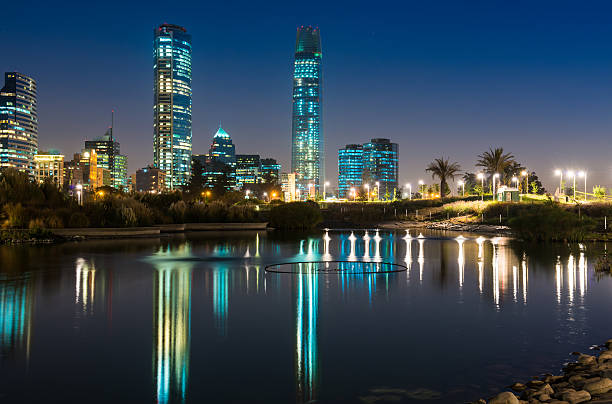
Networking Opportunities
One of the best parts about using coworking spaces in Santiago is the networking. Many of them host regular events, workshops, and community gatherings. I attended a few after-work socials, including wine tastings and even salsa lessons, which were a fantastic way to meet people.
These events are not only great for expanding your professional circle but also for experiencing Chilean culture firsthand. It’s a really easy way to connect with both locals and other nomads and build a community while you’re there.
Internet Connectivity And Speeds In Santiago
Let’s talk about the one thing every digital nomad needs: good internet. The great news is that Chile has some of the fastest and most reliable internet in all of Latin America. I never had any issues with connectivity during my stay.
Overview Of Internet Speeds
Chile consistently ranks high for its internet speeds. According to a recent report from Ookla, the country has an average fixed broadband download speed of over 265 Mbps. In Santiago specifically, you can expect excellent performance. The median download speed for fixed broadband is around 217 Mbps, with an upload speed of 126 Mbps.
You’ll find free Wi-Fi in most modern malls, cafes, and restaurants. I found it easy to stay connected whether I was working from a coworking space or a coffee shop.
Reliable Internet Service Providers
If you’re setting up a home base, you’ll want a reliable internet service provider. The main players in Santiago are Movistar, Entel, and Claro. Another provider, MundoPacifico, has been rated by Ookla as the fastest fixed ISP in Chile, with incredible median download speeds of over 350 Mbps.
These providers offer a range of packages, including fast fiber optic connections. You can get a solid high-speed plan for around $25-35 a month. Mobile data coverage is also extensive, with widespread 4G and 5G networks, so you can stay connected even when you’re on the go.
Safety And Security For Digital Nomads In Santiago
Santiago is generally a safe city, especially when compared to other major hubs in Latin America. However, like any big city, it’s always smart to be aware of your surroundings and take some basic precautions to stay safe.
Overview Of Safety Tips
Here are a few tips that I followed to ensure my stay was trouble-free:
- Keep Valuables Hidden: I tried not to flash my laptop, camera, or smartphone around in crowded public places. It’s just a good habit to avoid attracting unwanted attention.
- Be Smart with ATMs: Always use ATMs in well-lit, busy areas. I avoided withdrawing cash late at night and always shielded the keypad.
- Stay Aware of Your Surroundings: This is key. Pay attention when you’re walking alone, especially after dark. Petty crimes like pickpocketing can happen in busy tourist spots, so keep your bag secure.
- Use a VPN: When working on public Wi-Fi networks, I always use a VPN to encrypt my connection and protect my data.
Emergency Services Available
It’s always a good idea to have emergency numbers handy. In Chile, the main emergency number for an ambulance is 131. The police are the Carabineros de Chile, and you can reach them by dialing 133. The fire department is 132.
Santiago has excellent healthcare, with a mix of modern public and private hospitals like Clinica Alemana and Clinica Las Condes. It’s also wise to have good travel insurance that covers you for any medical emergencies.
Best Neighborhoods For Digital Nomads In Santiago
Choosing the right neighborhood can totally shape your experience in a city. In Santiago, I found a few areas that are particularly great for digital nomads, each with its own unique vibe.
Bellavista
Bellavista is known as Santiago’s bohemian quarter. It’s full of colorful street art, buzzing nightlife, and a fantastic artsy atmosphere. I loved the energy here. It’s packed with a huge variety of restaurants, bars, and cultural centers. It’s also close to Cerro San Cristobal, which offers some of the best views of the city.
Providencia
Providencia is a popular choice for both nomads and expats, and for good reason. It’s an upper-middle-class area that feels very safe, clean, and green. You’ll find some of the city’s best coworking spaces here, along with great shopping, cafes, and restaurants. It strikes a perfect balance between a relaxed residential feel and easy access to the city’s commercial hubs.
Lastarria
If you love a European vibe, you’ll feel right at home in Lastarria. This neighborhood has charming cobblestone streets, beautiful architecture, independent cinemas, and tons of great coffee shops. It’s a cultural hotspot, centrally located and perfect for anyone who wants to be in the heart of the action while enjoying a slightly more sophisticated atmosphere.
Things To Do For Digital Nomads In Santiago
One of the best things about Santiago is that there’s always something to do. Whether you want to dive into the culture, get outdoors, or enjoy the nightlife, the city has you covered.
Exploring The City’s Cultural Heritage
Santiago has a rich history, and you can see it everywhere. I recommend visiting some of the key historic landmarks, like the Palacio de La Moneda, Plaza de Armas, and Cerro San Cristobal. The city is also packed with fantastic museums. The Museo Nacional de Bellas Artes is a must-see, as is the powerful Museo Chileno de Arte Precolombino.
Outdoor Activities And Sports
Being so close to the Andes Mountains is a huge perk. Hiking is incredibly accessible, with popular spots like Cerro San Cristobal right in the city and more challenging trails in places like Cerro Manquehue. In the winter (June to October), you can go skiing at world-class resorts like Valle Nevado, which is just a short trip from the city.
Nightlife And Entertainment Options
Santiago has a really fun and diverse nightlife scene. The Bellavista neighborhood is the heart of the party, with tons of bars and clubs. For a more upscale vibe, the Vitacura area has chic bars and trendy lounges. And if you’re into live music, there are great venues all over the city, from small jazz clubs to larger concert halls.
Language Exchange Programs
If you want to brush up on your Spanish, Santiago is a great place to do it. There are tons of language exchange programs and meetups. Events organized through Tandem or Meetup groups are a fantastic way to practice your language skills, meet friendly locals, and make new friends from all over the world.
Visa Requirements For Digital Nomads In Chile
Navigating visa requirements is a key part of the nomad lifestyle. The good news is that Chile has options that work well for remote workers, even though a specific “digital nomad visa” is a relatively new concept.
Tourist Visa
For shorter stays, many nationalities, including citizens from the US and EU, can enter Chile without a visa and stay for up to 90 days. This is often called a tourist visa or permit on arrival. This permit can typically be extended once for another 90 days, giving you a total of 180 days in the country. While on this visa, you can work remotely for foreign companies.
Temporary Residency Visa
If you’re planning a longer stay, the Temporary Residency Visa is your best bet. This visa is an attractive option as it allows you to live in Chile for up to two years and work remotely for companies outside of Chile. The application process can be done online through Chile’s National Immigration Service portal. You’ll generally need to provide documents like a valid passport, proof of income, and a clean criminal record.
Conclusion
So, is Santiago the right fit for you? In my experience, it’s an ideal destination for digital nomads. It offers that rare combination of affordability, safety, and a vibrant culture that is hard to find. The city makes remote work incredibly easy with its fantastic coworking spaces and reliable, high-speed internet.
You’ll never run out of things to do, from exploring the mountains to enjoying the nightlife. Plus, with straightforward visa options, staying for a while is totally manageable. I had an amazing time in Santiago, and I have a feeling you will too.
FAQs:
1. What is a digital nomad and why would I choose Santiago as my destination?
A digital nomad is someone who works remotely while traveling the world. I found Santiago to be perfect because it offers a unique cultural experience, an affordable cost of living, and plenty of great co-working spaces to meet other like-minded people.
2. Are there any visa requirements for digital nomads in Santiago?
For stays under 90 days, many nationalities don’t need a visa. If you’re planning to stay longer, you can apply for a 90-day extension or look into the Temporary Residency Visa, which allows you to stay for up to two years.
3. What are some recommended co-working spaces in Santiago for digital nomads?
I’d recommend checking out WeWork, Launch Coworking, and Co-Work Latam. They all have great communities and all the amenities you need to be productive.
4. How can I find accommodation as a digital nomad in Santiago?
I had good luck with Airbnb for my apartment. You can also use sites like Booking.com. A great tip is to join local Facebook groups for expats and nomads in Santiago to get direct recommendations and find roommates if you’re interested.
